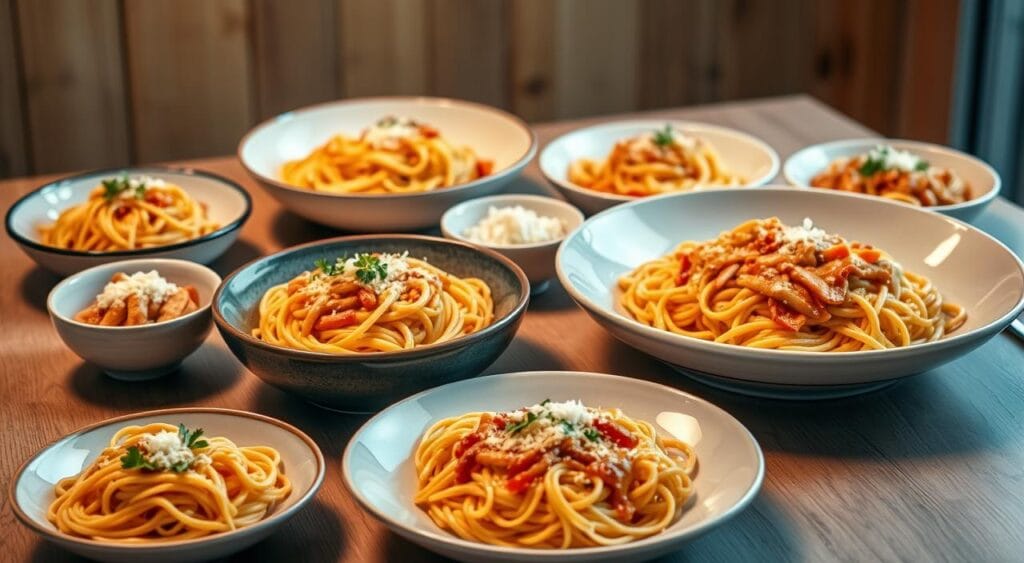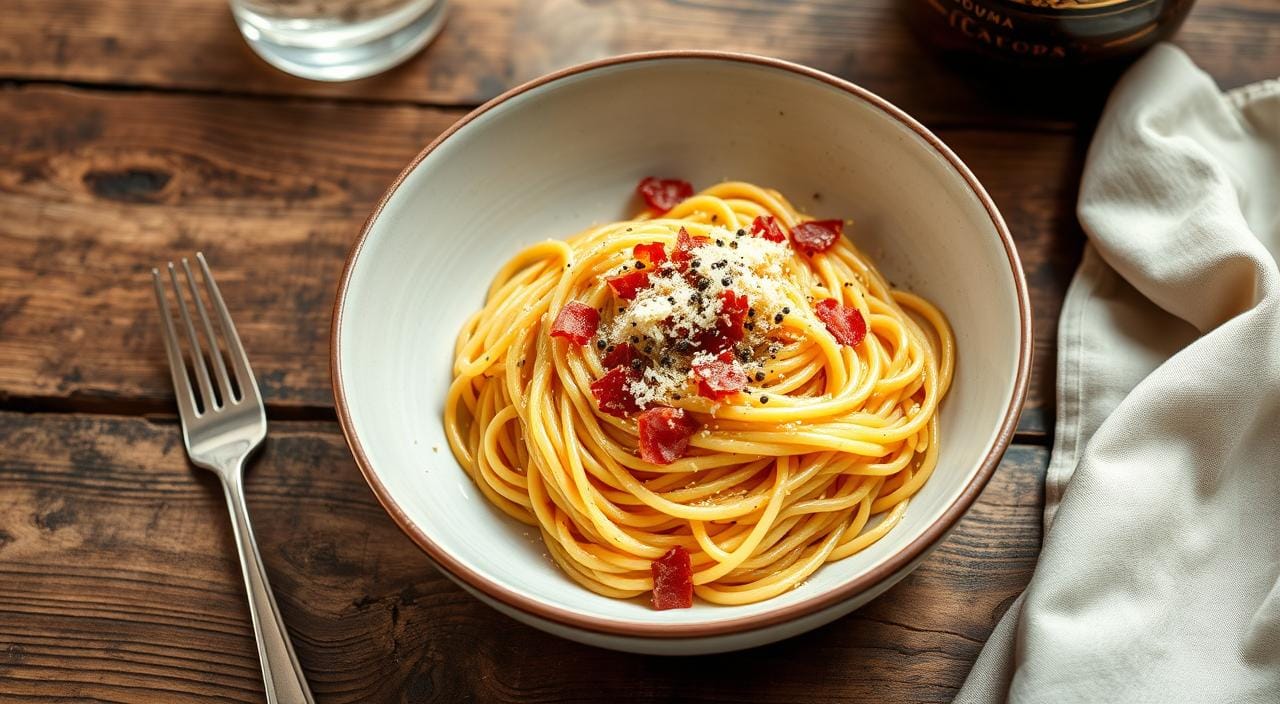Spaghetti Carbonara is a beloved Italian dish loved around the world. It’s simple yet rich in flavor, making it a favorite in many pasta and Italian recipe collections. The authentic recipe includes spaghetti, eggs, Pecorino Romano cheese, and guanciale or pancetta. These ingredients are key to getting the traditional taste of this Italian recipe.
This Italian dish comes from Rome and has a history dating back to the mid-20th century. It’s famous for its creamy sauce made with eggs, cheese, and cured pork. This makes it a top pick for those seeking a tasty and fulfilling pasta dish.
Key Takeaways
- Spaghetti Carbonara is a classic Italian dish with a rich history.
- The authentic recipe requires spaghetti, eggs, Pecorino Romano cheese, and guanciale or pancetta.
- The dish is known for its creamy sauce made with eggs, cheese, and cured pork.
- Using authentic ingredients is essential to achieving the traditional taste of this Italian recipe.
- Spaghetti Carbonara is a popular choice for those looking for a delicious and satisfying pasta recipe.
- The recipe can be modified cost-effectively by substituting guanciale with bacon and parmigiano reggiano with parmesan.
The Rich History of Carbonara in Italian Cuisine
Carbonara is a dish deeply rooted in Italian cuisine with a fascinating history spanning centuries. The name “carbonara” comes from the Italian word for “coal miner.” This is because it was loved by coal miners in the Apennine Mountains. It’s also closely tied to Rome, where it’s believed to have started.
The first mention of carbonara was in La Stampa newspaper in 1950. It was described as a favorite of American servicemen after the Allied liberation of Rome in 1944. This was the start of its popularity, making it a key part of Italian cuisine. It’s made with guanciale, eggs, and pecorino romano cheese. Sometimes, it also includes smoked bacon or cream.
- It is considered an urban dish that originates from Rome, particularly after the liberation in 1944.
- The typical cheese used in carbonara is pecorino romano, but variations may include Parmesan or Grana Padano.
- Guanciale is the traditional meat for carbonara; however, outside Italy, smoked bacon is frequently used as a substitute.
Learning about carbonara’s history and cultural background can make you appreciate it more. As a beloved part of Italian cuisine, it keeps changing and adapting. Yet, it stays true to its Rome origins.
Essential Ingredients for Perfect Carbonara
To make a perfect Spaghetti Carbonara, you need top-notch ingredients. This includes eggs, cheese, and pancetta. Guanciale is the traditional choice, but pancetta works well too. The perfect spaghetti carbonara recipe stresses the importance of quality ingredients.
The best pasta for Carbonara is bucatini, rigatoni, or spaghetti. These shapes are sturdy and chewy. For eggs, use 3 egg yolks and 1 whole egg. This mix gives a richer flavor and better sauce.
Other key ingredients are pancetta, cheese, and eggs. For a classic carbonara, use 1 pound of spaghetti, 1/2 pound of pancetta or thick-cut bacon. Add 3 to 4 whole eggs and 1 cup of grated Parmesan or Pecorino cheese. For more info, check out food blogs.
The Truth About Authentic Pasta Carbonara
Many people think Pasta Carbonara needs cream, but it doesn’t. The real recipe is simple. It uses guanciale or pancetta, eggs, and Parmigiano-Reggiano cheese.
For more on Italian cooking, check out Leslie Recipes. They suggest using thick spaghetti, bucatini, or linguini. These pasta types add a special texture to the dish.
Some people add mushrooms or bell peppers to Pasta Carbonara. But, these changes can make the dish less authentic. To taste the real Pasta Carbonara, stick to the traditional recipe and use top-notch ingredients.
Common Misconceptions
- The use of cream is not traditional in Pasta Carbonara.
- Guanciale or pancetta is essential for an authentic flavor.
- The dish should not include garlic or onions.
Traditional vs. Modern Variations
There’s a big debate about Pasta Carbonara’s authenticity. Some say modern versions are just as good as the traditional one. It really comes down to what you like better.
Choosing the Right Equipment
When making Spaghetti Carbonara, the right equipment is key. You’ll need a big pot for boiling pasta and a skillet for the sauce. A stand mixer with pasta attachments can also speed up making pasta.
The cost of equipment varies a lot. A top-of-the-line machine might cost about $600. But, an electric pasta roller is just $87. Manual pasta machines start at $220. You can also find wooden surfaces for dough for $20 to $30, and basic rolling pins for $12 to $13.
- Manual pasta machine: $220
- Electric pasta roller: $87
- Wooden surface for rolling out dough: $20 to $30
- Rolling pin: $12 to $13
- Specialized tools like drying screens or pasta racks: $35
With the right equipment and techniques, you can make Spaghetti Carbonara as good as Italian restaurants.
Selecting Quality Ingredients
Choosing the right ingredients is key to a great Spaghetti Carbonara. You need the best pasta, cheese, and eggs for an authentic taste. The right mix of these will make your dish truly Italian.
Start with top-notch pasta, like Italian durum wheat semolina pasta. Brands like Pasta Martelli and Garofalo are known for their quality, scoring 10/10 and 7-8/10, respectively.
For a creamy sauce, fresh quality eggs are essential. Look for eggs with a good yolk-to-white ratio. High-quality cheese, like Pecorino Romano and Parmigiano-Reggiano, adds depth and flavor. By focusing on these ingredients, your Carbonara will be authentic and delicious.
Step-by-Step Cooking Method
To make the perfect Spaghetti Carbonara, follow a step-by-step guide. Start by making a sauce base with eggs, cheese, and cured pork. Then, mix it with cooked spaghetti. Pay close attention to temperature and timing for the right consistency.
The traditional method begins with preparing the sauce base. Whisk eggs, grated cheese, and cured pork in a bowl. Cook spaghetti in boiling water until it’s al dente, which takes about 10-12 minutes. While the pasta cooks, heat the sauce base in a pan over low heat, stirring constantly.
After the pasta is done, drain it and add it to the sauce base. Toss until the spaghetti is well coated. If the sauce is too thick, add some reserved pasta water. This method will help you make a delicious, authentic Spaghetti Carbonara.
When cooking Spaghetti Carbonara, use high-quality ingredients like fresh eggs and real cheese. Also, watch the cooking time to get the perfect texture. By following these steps and tips, you’ll make a mouth-watering dish that will impress everyone.
Understanding Pasta Science
When cooking the perfect pasta, pasta science is key. Things like starch release, water temperature, and cooking time matter a lot. Knowing these can help you get the perfect texture.
To use pasta science in cooking, remember these important points:
- Starch molecules start to soak up water at temperatures as low as 180°F.
- Pasta cooks well at any temperature above 180°F.
- More water keeps heat better than less water.
For instance, when cooking capellini, it’s crucial to think about
By knowing and using pasta science in cooking, you can make tasty pasta dishes every time.
Common Mistakes to Avoid
When making Spaghetti Carbonara, it’s easy to make mistakes that change the taste and texture. One big mistake is not controlling the temperature right. This can make the eggs scramble or the dish feel wrong.
Another big error is swapping out ingredients. This can really change how the dish tastes.
To avoid these mistakes, it’s key to know how to control the temperature and the role of each ingredient. Here are some common mistakes to watch out for:
- Incorrect temperature when cooking the pasta or preparing the sauce.
- Substituting ingredients without considering their impact on the final product.
- Not using the right ratio of ingredients, leading to an imbalance in flavor and texture.
By knowing these mistakes and avoiding them, you can make sure your Spaghetti Carbonara is just right. It will have the perfect mix of flavors and textures. This is thanks to careful temperature control and using top-notch ingredients.
Regional Italian Variations
Italian cuisine is famous for its regional diversity. Spaghetti Carbonara is a great example. It started in Rome but has spread across Italy, with each region adding its own twist. This has created many variations.
In Northern Italy, places like Lombardia, Piemonte, and Liguria have their own special dishes. You can find trofie pasta with basil pesto, agnolotti with veal, and pizzoccheri made from buckwheat. Central Italy, including Toscana and Umbria, is known for its hand-rolled pasta like pici and tagliatelle. These are often served with meat ragù or fresh truffles.
Southern Italy stands out for its pasta made from durum wheat flour and water. You’ll find shapes like paccheri, casarecce, and fileja. These are paired with local ingredients like wild boar ragù, ‘Nduja, and Cime di Rapa greens. This shows the variety and richness of Italian cuisine.

Some highlights include orecchiette from Puglia, spaghetti alla chitarra from Abruzzo, and malloreddus from Sardegna. These variations show how creative and adaptable Italian cuisine is. Each region has its own twist on traditional dishes, offering a wide range of Italian variations to try.
Wine Pairing Suggestions
Finding the right wine for Spaghetti Carbonara can make your meal better. Choose crisp white wines or light red wines. They match the creamy sauce and rich flavors well.
Think about the wine’s qualities. A wine with good acidity can balance the sauce’s richness. Fruity notes can also boost the taste. Good choices include white wines like Pinot Grigio or Chardonnay, and light-bodied red wines like Sangiovese or Chianti.
White Wine Options
White wines are a favorite for Carbonara. Here are some:
- Pinot Grigio
- Chardonnay
- Vermentino
Red Wine Choices
Light red wines also pair well with Carbonara. Here are some:
- Sangiovese
- Chianti
- Montepulciano d’Abruzzo
Your wine choice depends on what you like. But, think about the wine’s qualities and the dish’s flavors. This way, you can pick a wine that perfectly complements your Spaghetti Carbonara.
Storing and Reheating Tips
Storing and reheating pasta right is key to keeping its taste and quality. Cooked pasta can stay in an airtight container for up to 5 days. This makes it perfect for meal prep. For reheating, you can use the oven, microwave, or stovetop.
Here are some storing and reheating methods:
- Refrigerate cooked pasta for up to 5 days
- Freeze cooked pasta for up to 2 months
- Reheat pasta in the oven at 350℉ for 15-20 minutes
- Reheat pasta in the microwave for 1-2 minutes per 2 cups
To avoid clumping and drying, add a bit of water or pasta sauce when reheating in the microwave. Covering the pasta loosely helps keep it moist. By using these tips, you can enjoy your pasta even after it’s been stored.
Always check the pasta for spoilage before eating. Store it in a sealed container to stop bacteria and mold. With these storing and reheating tips, your pasta will stay fresh and tasty longer.
Making Carbonara for Different Serving Sizes
When making Carbonara, adjustments are key to a great taste. It doesn’t matter if you’re cooking for one or a big family. Knowing the right amounts of ingredients is essential.
A standard serving size is about 75 grams of pasta. To adjust for different serving sizes, just scale the ingredients. For one person, use 100 grams of pasta, 30 grams of pecorino romano, and 66.67 grams of guanciale.
Here are some tips for adjustments:
- For one person, use 100 grams of pasta and adjust the other ingredients.
- For a family, use 300 grams of pasta and increase the other ingredients.

With these adjustments and the right ingredient amounts, you can make delicious Carbonara for any serving size.
Dietary Modifications and Substitutions
For those with dietary restrictions, making modifications to Carbonara can be a good solution. This includes substitutions like gluten-free pasta or vegetarian guanciale. These changes make the dish tasty and fit for different diets.
Popular substitutions include zucchini noodles or spaghetti squash. They’re low in carbs and full of nutrients. Others might choose pasta made from black beans, lentils, or chickpeas. These are high in protein and fiber. These modifications let people enjoy a dietary Carbonara that suits their needs.
When swapping ingredients, think about their nutritional and taste values. Gluten-free pasta might need different cooking times and liquid amounts. Replacing guanciale with a vegetarian option can change the dish’s flavor and texture. Knowing these details helps make a dietary Carbonara that’s both tasty and fulfilling.
Conclusion
Making a real pasta Carbonara is more than just following a recipe. It’s an art that goes beyond simple steps. By learning about its history, key ingredients, and traditional ways, anyone can make this Italian favorite.
If you love cooking or just enjoy trying new dishes, this guide has you covered. It gives you the skills to make a Spaghetti Carbonara that’s both delicious and satisfying. With the right ingredients and methods, you can take this classic dish to a whole new level.
Keep exploring the world of Italian cooking, especially with Spaghetti Carbonara. It’s a dish that can bring joy and great taste to your meals. Enjoy your culinary adventures and the time spent with your family and friends. Buon appetito!
FAQ
What is Spaghetti Carbonara?
Spaghetti Carbonara is a beloved Italian dish loved worldwide. It’s known for its simplicity and rich flavor. The recipe includes spaghetti, eggs, Pecorino Romano cheese, and guanciale or pancetta.
What is the history of Carbonara?
Carbonara comes from Rome and has changed over time. It’s a big part of Italian cuisine, loved by locals and tourists.
What are the essential ingredients for Spaghetti Carbonara?
Making authentic Spaghetti Carbonara requires top-notch ingredients. This means using the right pasta, eggs, cheese, and cured pork.
What are the differences between traditional and modern Carbonara variations?
Some recipes stray from the true Carbonara method. This can change the dish’s taste and authenticity.
What equipment is needed for preparing Spaghetti Carbonara?
The right kitchen tools are crucial. You’ll need pots, pans, utensils, and serving dishes.
How do I select the best ingredients for Spaghetti Carbonara?
Choose the best pasta, Pecorino Romano and Parmigiano-Reggiano cheese, and fresh eggs. These are key for a delicious Carbonara.
What is the step-by-step cooking method for Spaghetti Carbonara?
First, prepare the sauce base. Then, cook the pasta al dente. Finally, assemble the dish carefully to avoid scrambled eggs.
How does pasta science affect the outcome of Spaghetti Carbonara?
Pasta science is important. It helps achieve perfectly cooked spaghetti every time, making your Carbonara better.
What are common mistakes to avoid when making Spaghetti Carbonara?
Avoid temperature control mistakes and ingredient swaps. Knowing these pitfalls helps you make a better Carbonara.
How do regional variations of Spaghetti Carbonara differ?
Italy’s regions have their own Carbonara twists. They add local flavors and ingredients, showing the dish’s versatility.
What wine pairings complement Spaghetti Carbonara?
There are great white and red wines for Carbonara. They match its creamy sauce and rich flavors perfectly.
How can I store and reheat Spaghetti Carbonara?
To keep Carbonara fresh, follow some tips. This ensures it stays tasty and flavorful when reheated.
How do I adjust the Spaghetti Carbonara recipe for different serving sizes?
Scaling the recipe is easy. You can make it for one or for a big family, keeping the flavors balanced.
What dietary modifications or substitutions can be made for Spaghetti Carbonara?
You can make Carbonara work for different diets. Try using vegetarian alternatives or gluten-free pasta without losing flavor.

